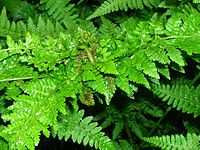- Chirosia betuleti
-
Chirosia betuleti 
Knotting gall on Broad buckler fern Scientific classification Kingdom: Animalia Phylum: Arthropoda Class: Insecta Order: Diptera Family: Anthomyiidae Genus: Chirosia Species: C. betuleti Binomial name Chirosia betuleti
(Ringdahl, 1935)The Knotting gall, is caused by the dipteron fly Chirosia betuleti (Ringdahl, 1935). The gall develops in the terminal shoots of ferns, such as Broad buckler fern Dryopteris dilatata, Male shield fern Dryopteris filix-mas, Lady fern Athyrium filix-femina,[1][2] and the Ostrich fern, Matteuccia struthiopteris.[3]
Contents
The physical appearance of the galls
The fly larva mines the leaves and stems of the fern's frond at the apex. The tip of the frond rolls upwards into a loose, obvious knot or mop-head structure involving many pinnae; inside a white larva mines along the rachis, eating the trichomes, causing it to coil. Usually only one larva is present in the leaf tip, sometimes two. An elongated white egg shell is visible at the centre of the mass[4]
Life-cycle
Eggs are laid in the unfurling fronds and the hatched larvae feed on the trichomes in the groove of the rachis causing the frond to curl inwards. The pupae drop from the gall and remain from autumn and winter to emerge in the spring. Galling rates of up to nine fronds out of 13 on a single plnat have been noted.[3]
Distribution
The Knotting gall is found in Cornwall, Wiltshire, Worcester, Hants, Norfolk, Warwickshire, Berkshire, Cardiganshire, Cheshire, Denbighshire, East Norfolk, Suffolk, Easterness, Elgin, Flintshire, North Ayrshire, Herefordshire, Merionethshire, Perth, Yorkshire, Montgomeryshire, Lincolnshire, Somerset, Oxfordshire, Shropshire, Devon, Hampshire, Yorkshire, Stafford, Surrey, Gloucestershire, Kent, Suffolk and Worcestershire.[4]
As shown, the Knotting gall has been recorded throughout the United Kingdom, in the Netherlands, Czech Republic, Denmark, Finland, France, Germany, Italy, Norway, Poland, Russia - North and Northwest, Slovakia, Spain and Sweden.[4]
Parasitoids
Braconid wasps of the genus Aphaereta and eulophid wasps of the genera Dimmockia and Elachertus have been identified as parasitoids of C. betuleti.[3]
See also
- Fern sports
- Galls
References
- Notes
- Sources
- Darlington, Arnold (1968). The Pocket Encyclopaedia of Plant Galls in colour. Pub. Blandford Press. Dorset. ISBN 0-7137-0748-8
- Hancy, Rex (2000). The Study of Plant Galls in Norfolk. The Norfolk and Norwich Naturalist's Society.
- Redfern, Margaret & Shirley, Peter (2002). British Plant Galls. Identification of galls on plants & fungi. AIDGAP. Shrewsbury : Field Studies Council. ISBN 1-85153-214-5.
- Stubbs, F. B. Edit. (1986) Provisional Keys to British Plant Galls. Pub. Brit Plant Gall Soc. ISBN 0-9511582-0-1.
Categories:
Wikimedia Foundation. 2010.

